Miscellaneous Medical Bags, Packs & Containers
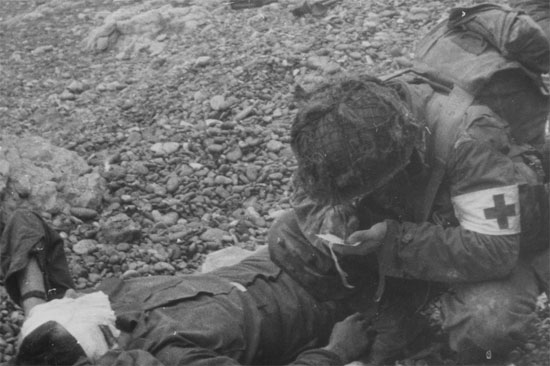
A Medic of the 1st Infantry Division checks the details of a wounded GI’s Emergency Medical Tag on Omaha Beach, June 1944.
Overview:
In addition to the numerous packs and containers issued by the Medical Department for the storage and transportation of items in the field, a number of additional packs and containers were developed by individual units to serve a specific purpose within the organization. The aim of this article is to look at the development of rigger-made medical bags and packs, as well as how these items were used in the field, and the ways in which they influenced the Medical Department throughout the duration of WW2.
It should be noted by re-enactors in particular that the items which appear herein did not often see widespread use outside of the units which are discussed. Most of the pieces were developed by members of the respective organizations to fulfil a specific role within the unit, some later being adopted by the US Army for widespread issue. As such, this Article should be used in conjunction with thorough unit research in order to put together an accurate medical impression.
Kit, Medical, Parachutist:
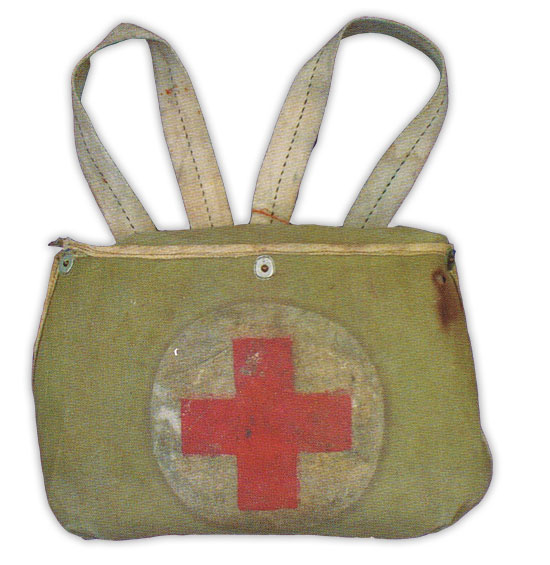
Example of the Parachutist Medical Kit. Note the three “Lift-The-Dot” fasteners for securing the item during a parachute jump.
Illustration courtesy of the Carentan Historical Center
The Parachutist Medical Kit was developed and produced by riggers of the 82d Airborne Division sometime in early 1944. The kit’s design was loosely based upon the US Marine Corps’ Medical Drop Kit. The latter saw contained use during training in Oujda and later in Operation Torch with the 307th Airborne Medical Company (82d Airborne Division).
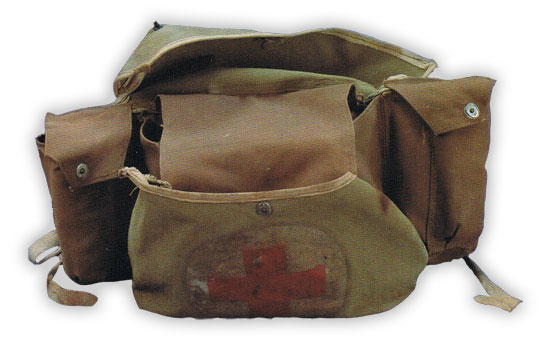
Photograph showing the internal compartments of the Parachutist Medical Kit. Of interest is the large Geneva Convention symbol which has been applied to the front of the Kit.
Illustration courtesy of the Carentan Historical Center
The kit was made from heavy Olive Drab canvas, with two large shoulder loops attached to the rear made from white parachute harness material. A large closing flap was attached to the kit which allowed three internal pockets to be protected during the jump. This outer flap was closed by means of three “Lift-The-Dot” fastenings; one in the center, one in the left corner, and one in the right. It was commonplace for this front flap to also be adorned with Geneva Convention symbols – typically a Greek-style red cross inside a circular white field (some remaining original examples also have this white field outlined with a solid black border). Inside, the kit contains three pockets, two small ancillary pockets which ordinarily fold in when the bag is to be carried on the back or above the chest pack parachute during the jump, and a larger pocket in the center. Each pocket is closed by means of a canvas flap with a single “Lift-The-Dot” fastening in the middle. To each ancillary pocket is attached a cotton tape which can be used to tie the three pockets together during the jump.

Photograph showing members of the 326th Airborne Medical Company (101st Airborne Division) in England before the Normandy invasion. Notice that the Record Clerk carries the Parachute Medical Kit underneath the Chest Pack of his T-5 Parachute. Another Kit is shown open in the bottom right corner.
Illustration courtesy of the Carentan Historical Center
The Medical Drop Kit was to be issued to the ten Enlisted Men of each Battalion Medical Section and each Medical Officer within the Airborne Medical Company – a total of 50 being required per Airborne Division. The main purpose of the kit was to supplement equipment taken into combat by the regular Aid Men (who were equipped with the Kit, Medical, Parachutist’s [Item # 9711600]); to resupply essential items, and to carry in the necessary equipment for the Regimental Aid Station. In order that the kit could achieve all of these goals, a contents list was prepared by the 505th Parachute Infantry Regiment Medical Detachment. The original documents instruct that kits should be labelled from 1 to 10 in some distinguishable manner and contain the following items:
| Kit No. 1 – Carried by Medical Officer | ||
| Large Carlisle Dressing | 2 | |
| 2030000 | Packet, First-Aid, Carlisle Model | 6 |
| 9115500 | Morphine Tartrate, 5 Tubes | 2 (boxes) |
| 9121100 | Sulfanilamide, Crystalline, 5, 5-Gm Envelopes | 4 (boxes) |
| 2003185 | Bandage, Gauze, Compressed, 3 In. x 4 Yds. | 8 |
| 9705000 | Case, Instrument, Medical Officer’s, Complete | 1 |
| 9210500 | Sponge, Surgical, 2-Inch by 2-Inch, 100 | 50 |
| Kit No. 2 – Carried by Medical Officer | ||
| Large Carlisle Dressing | 2 | |
| 2030000 | Packet, First-Aid, Carlisle Model | 2 |
| 9115500 | Morphine Tartrate, 5 Tubes | 4 (boxes) |
| 9121100 | Sulfanilamide, Crystalline, 5, 5-Gm Envelopes | 4 (boxes) |
| 2003185 | Bandage, Gauze, Compressed, 3 In. x 4 Yds. | 8 |
| 9951500 | Sterilizer, Hypodermic Needle | 1 |
| 3844000 | Syringe, Luer, 2-cc | 2 |
| 3845000 | Syringe, Luer, 10-cc | 1 |
| 3846000 | Syringe, Luer, 30-cc | 2 |
| 1330810 | Pentothal Sodium, 25 1-Gm Ampules | 2 (ampules) |
| Needles | ||
| Kit No. 3 – Carried by Surgical Technician | ||
| Large Carlisle Dressing | 2 | |
| 2030000 | Packet, First-Aid, Carlisle Model | 6 |
| 9115500 | Morphine Tartrate, 5 Tubes | 4 (boxes) |
| 9121100 | Sulfanilamide, Crystalline, 5, 5-Gm Envelopes | 4 (boxes) |
| 2003185 | Bandage, Gauze, Compressed, 3 In. x 4 Yds. | 8 |
| 1330810 | Pentothal Sodium, 25 1-Gm Ampules | 2 (ampules) |
| 2035000 | Plaster, Adhesive, Surgical, 3-Inch by 5 Yards | 4 (tins) |
| Kit No. 4 – Carried by Surgical Technician | ||
| Large Carlisle Dressing | 2 | |
| 2030000 | Packet, First-Aid, Carlisle Model | 6 |
| 9115500 | Morphine Tartrate, 5 Tubes | 4 (boxes) |
| 9121100 | Sulfanilamide, Crystalline, 5, 5-Gm Envelopes | 4 (boxes) |
| 2003185 | Bandage, Gauze, Compressed, 3 In. x 4 Yds. | 8 |
| 1330810 | Pentothal Sodium, 25 1-Gm Ampules | 2 (ampules) |
| Sterile Vaseline Gauze | 4 (tins) | |
| Kit No. 4 – Carried by Gas NCO – labelled “Gas Kit” * | ||
| 9109525 | Eye Solution, BAL, 1/2 oz (M-1) | 2 |
| 9363600 | Kit, Eye Surgery | 4 |
| 1354400 | Pontocaine Compound Ointment, 1 oz | 4 (tubes) |
| 1339600 | Phenobarbital, 100 Tablets | 500 (tablets) |
| 1413715 | Sodium Amytal, 500 Capsules | 1,000 (capsules) |
| 3684000 | Gloves, Surgeon’s, Size 8 | 10 (pairs) |
| 9210500 | Sponge, Surgical, 2-Inch by 2-Inch, 100 | 200 |
| 9107500 | Copper Sulfate Solution, approximately 2-oz Bottle | 3 (bottles) |
| 7493000 | Soap, White, Floating, 6 oz | 2 (bars) |
| 9118700 | Protective Ointment, CWS, 3 oz | 4 (tubes) |
| Butyn & Mercuric Ointment, 15% | 6 (tubes) | |
| 9104000 | Tannic Acid Sulfadiazine Ointment | 4 (tubes) |
| 1085000 | Atropine Sulfate, 1/8 oz | 4 (ounces) |
| 9115500 | Morphine Tartrate, 5 Tubes | 2 (boxes) |
| 1149500 | Codeine Sulfate, USP, 1/2-Gr Hypo Tablets | 1,000 (tablets) |
| Diachloramine T 16 2/3%, in: | ||
| Triacetin | 16 (ounces) | |
| 1228500 | Hydrogen Peroxide Solution, 3% 1 lb | 8 (ounces) |
* Since it was the responsibility of the Medical Detachment to provide most of the treatment to gas casualties, the kits labelled “Gas Kits” were to be turned over to Aid Men and Aid Stations where they were of greater and more efficient use.
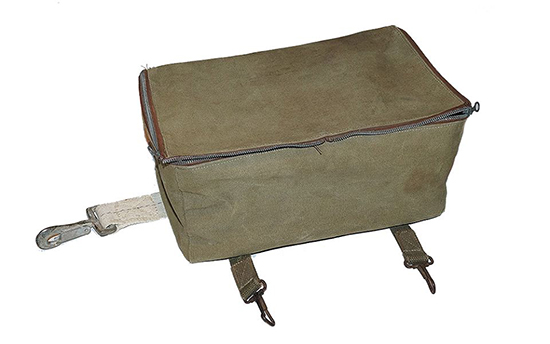
Illustration showing an alternate design of the Parachutist Medical Kit. The Kit has a large parachute snap attached to the rear for securing the item on the parachute harness. Two short straps complete with spring clips are also provided, likely for attaching it to D-rings on the Suspenders.
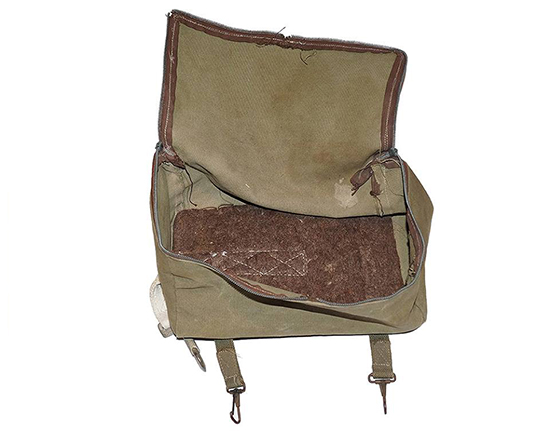
Photograph showing the interior of the Rigger-made Parachutist Medical Kit. The bottom features additional padding which has been removed from Aerial Delivery Container cushions.
| Kit Nos. 6, 7, 8, 9 and 10 | ||
| Large Carlisle Dressing | 2 | |
| 2030000 | Packet, First-Aid, Carlisle Model | 6 |
| 9115500 | Morphine Tartrate, 5 Tubes | 4 (boxes) |
| 9121100 | Sulfanilamide, Crystalline, 5, 5-Gm Envelopes | 4 (boxes) |
| 2003185 | Bandage, Gauze, Compressed, 3 In. x 4 Yds. | 8 |
| 9210700 | Sponge, Surgical, 4-Inch by 4-Inch, 100 | 500 |
| 1606500 | Normal Serum Albumin (Human), Concentrated | 1 |
| 1330810 | Pentothal Sodium, 25 1-Gm Ampules | 1 (box) |
| 3754000 | Splint, Wire Ladder | 1 |
| Sterile Vaseline Gauze | 4 (tins) | |
In addition to the list above, kit numbers 6, 7, 8, 9 and 10 were also to carry additional EMT Booklets when the kit was to be carried by a Battalion Clerk.
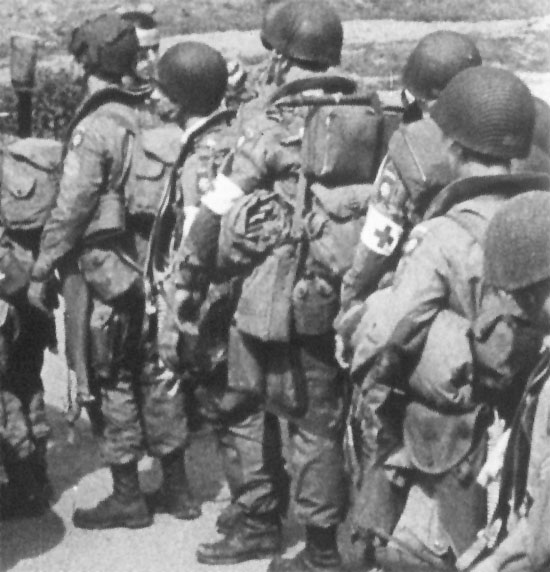
Members of the 505th Parachute Infantry Regiment (82d Airborne Division) leave their staging area in readiness for Operation Neptune. Notice both members of the 505th PIR Medical Detachment wear the rigger-made pouch above their M1936 Musette (Canvas Field Bag).
Illustration courtesy of the Carentan Historical Center
Pouch, Medical, Parachutist (Stock No. 74-P-284):
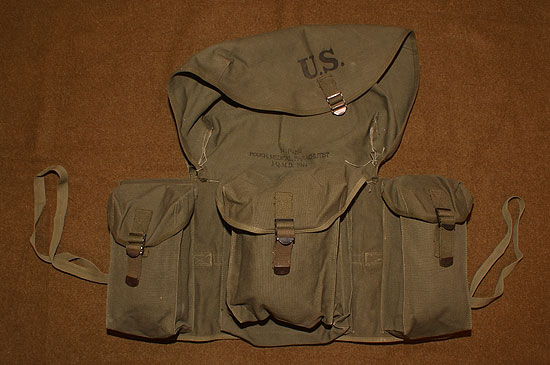
Illustration showing the internal arrangement of the Parachutist Medical Pouch. This particular example has been produced by the Jefferson Quartermaster
Depot in 1944.
The Parachutist Medical Kit proved to be extremely useful for transporting the equipment necessary for establishing a fully-functional Aid Station by Airborne troops, inasmuch as the US Army’s Quartermaster Corps began development of an official pack based upon the examples produced by Airborne riggers. Development began on this new piece of equipment in 1944 shortly after the successes of the Parachutist Medical Kit had been observed in Operation “Neptune”, and production was started almost immediately. The item, based on US Army Specification JQD 537, was described in the Army Service Forces Catalog QM 3-1, dated May 1946 as – Pouch with adjustable shoulder straps, which may be worn on the chest or back, to carry medical supplies. It is most likely that the Pouch was worn on the chest for easy access. The item’s weight was 2.86 lbs.
The overall layout and approximate dimensions of the kit are almost identical to the pieces produced by the rigger teams. A few slight amendments were made; most notable was the replacement of the “Lift-The-Dot” fasteners in favor of a strap and buckle mechanism on the internal pockets and larger closing flap of the pouch.
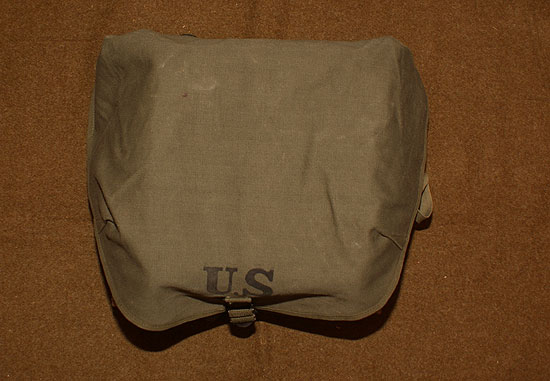
Photograph showing the Pouch closed. Notice the large “U.S.” marking applied above the securing strap on the closing flap.
Although a number of these pouches can be found dated 1944, very few (if any) actually saw widespread service among Airborne troops before Operation “Varsity” in 1945. These pieces continued to be produced in the immediate post-WW2 period, although production seems to have stopped in 1950.
As the item was produced by the Quartermaster Corps, rather than the Medical Department, no official contents list exists. However, it can generally be assumed that since the purpose of the Pouch was primarily a replacement for the rigger-made examples, the contents did not significantly vary from the lists outlined above.
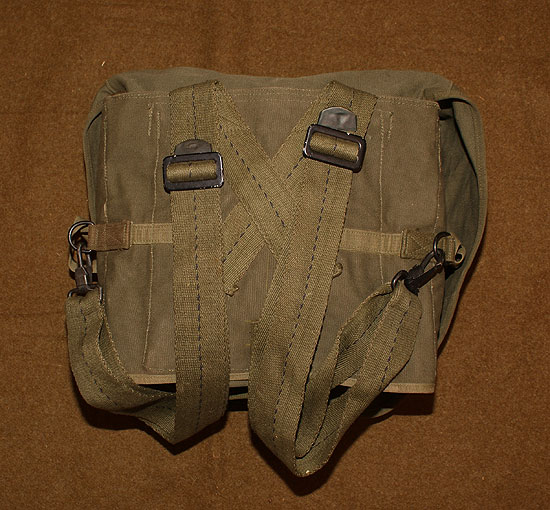
The large, heavy-duty carrying straps can be seen here attached the rear of the Pouch. Notice also the heavy spring clips used to secure the straps to the
D-rings of the Pouch.
Bag, Waterproof, Double Texture, General Purpose, Type I (Stock No. 24-B-1258):
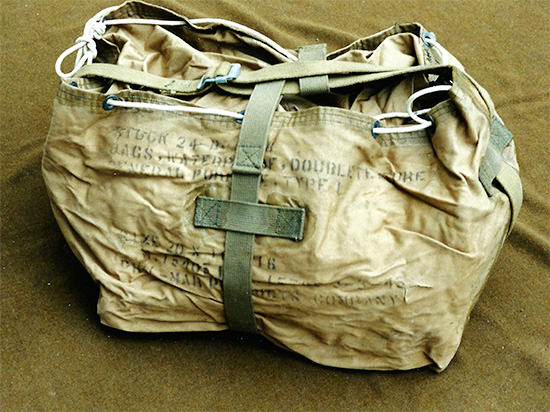
Illustration of Bag, Waterproof, Double Texture, General Purpose, Type I, QMC Stock No. 24-B-1258.
The Bag is a rectangular shaped item made from a double layer of waterproof medium weight olive drab # 3 (khaki) sateen cloth.
The Waterproof Bag features a throat made from a single layer of waterproof sateen, so designed that when drawn shut with the cord provided for this purpose, it is completely waterproof.
There is an additional closing strap with square buckle that wraps around the entire bag when filled.
Development took place in 1944 and although the authors have never seen any photographs illustrating the item, it can be assumed that such piece of equipment may have been used during Operation “Neptune” along with the series of other Waterproof Bags, Special Purpose (used to protect equipment against rain, spray, and immersion during amphibious operations).
General dimensions are 20“ x 16” x 16” and Quartermaster Corps Stock No. is 24-B-1258.
As the item was produced by the Quartermaster Corps, neither an official Medical Department Item Number nor a contents list exists. However, The Quartermaster Supply Catalog QM 3-4, 1945, describes it as an ALL-PURPOSE Bag, used for carrying miscellaneous equipment such as wool blankets, surgical equipment, dressings etc.
Remark:
There is another example of this kind of equipment, developed by the QMC and designated Bag, Waterproof, Double Texture, General Purpose, Type II (Stock No. 24-B-1260). Overall size 24” x 24” x 42”.
Bag, Waterproof, Special Purpose (Stock No. 24-B-1263-200):
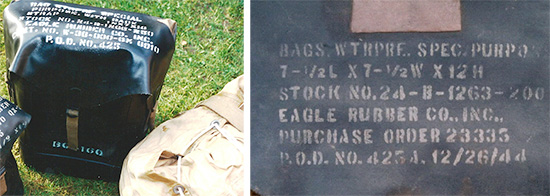
Left: Illustration of Bag, Waterproof, Special Purpose, QMC Stock No. 24-B-1265-250.
Right: Illustration showing white stenciled markings on cover of Bag, Waterproof, Special Purpose, QMC Stock No. 24-B-1263-200.
As early as 1943 a series of Special Purpose Bags were developed by the Quartermaster Corps and introduced for use in Amphibious Operations. The basic reason was to develop Waterproof Bags to protect special Signal Corps radio equipment against natural elements, such as rain, spray, and immersion during Amphibious and other Landing Operations.
A number of Bags, Waterproof, Special Purpose, were therefore designed and introduced. They came in a variety of shapes and dimensions, intended to protect specific types of equipment. For additional protection Signal Corps equipment were often wrapped in double texture fabric against rain or water during Amphibious Operations. This item was designated Paulin, Waterproof, Special Purpose, 10-Inch Long x 8-Inch Wide (Stock No. 24-P-47-200).
The Bags were available in six (6) different versions:
- Bag, Waterproof, Special Purpose, QMC Stock No. 24-B-1263-200, size 7½ “ long x 7½ ” wide x 12” high
- Bag, Waterproof, Special Purpose, QMC Stock No. 24-B-1263-500, size 12” long x 9” wide x 18” high
- Bag, Waterproof, Special Purpose, QMC Stock No. 24-B-1264-150, size 16½” long x 15½ “ wide x 27” high
- Bag, Waterproof, Special Purpose, QMC Stock No. 24-B-1264-400, size 20½” long x 16½” wide x 11¼” high
- Bag, Waterproof, Special Purpose, QMC Stock No. 24-B-1264-450, size 21” long x 15” wide x 14” high
- Bag, Waterproof, Special Purpose, with Back Strap, QMC Stock No. 24-B-1265-250, size 12” long x 7” wide x 16” high
It is clear that such Bags were often used to pack and protect other equipment as well.

Photo illustrating range of Bags, Waterproof, Special Purpose, especially developed by the Quartermaster Corps for use during amphibious operations in World War Two.
Container, Round, Insulated, M-1941, with Inserts (Stock No. 64-C-1105):
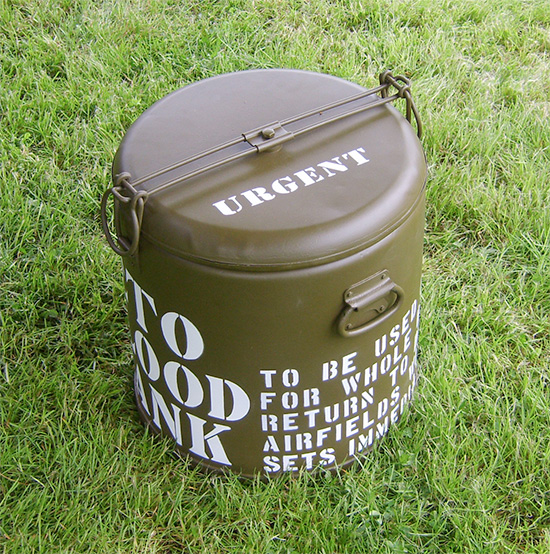
Illustration of “ETO Blood Bank” Container”, QMC Stock No. 64-C-1105.
The Insulated Container was designed by the Quartermaster Corps for transporting food. It was provided with three (3) different Inserts that could contain hot food. The capacity of the Container was such that it could accommodate 7 Gallons in total. Three (3) 1¾-gallon Inserts with Clamp Covers; or one (1) 4-gallon Insert and one (1) 1¾-gallon Insert fitted into the well of the Container which was insulated in order to keep the food hot during transportation and distribution.
The weight of the Container without Inserts was 30 lbs, while the weight with Inserts went up to 43½ pounds.
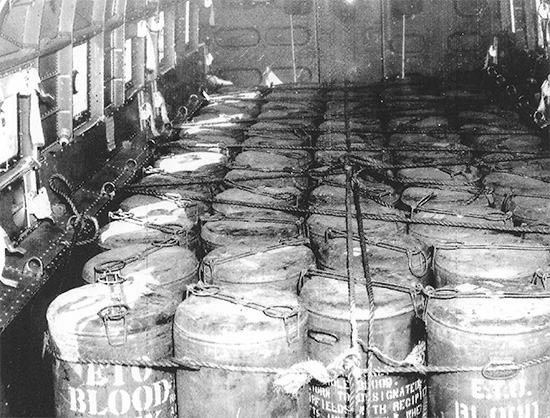
“ETO Blood Bank” Containers on their way to the Continent. Picture taken on board a C-47 cargo plane, following D-Day Operations.
Since a new type of Container for food was introduced in 1944; Container, Food, Insulated, M-1944, Stock No. 64-C-1082, the current equipment became “Limited Standard – To be Issued until Exhausted”. As such the Medical Department picked up the Containers for their proper use – for transportation of Blood – which proved an excellent solution. Inserts were removed, markings applied, and the “marmites” or “food containers” began a new life as a well-known piece of medical equipment. Most of today’s collectors and re-enactors are familiar with the “ETO Blood Bank” containers.
Pack, Unit Medical Equipment, No. 5 (Item No. 9794800):
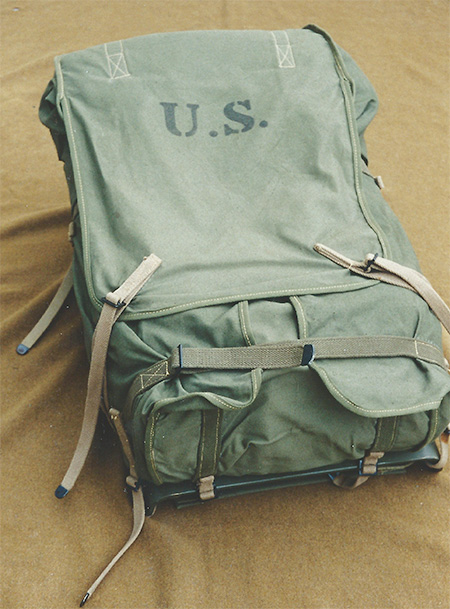
Illustration showing Pack, Unit Medical Equipment (this could be any type of Unit, as only contents differed) mounted on a standard Packboard frame.
Canvas Medical Packs were being tried out in 1943 as a possible substitute for the Medical Chests for use at forward Aid Stations. Two (2) of such Packs, weighing about 40 pounds each, would favorably replace a Medical Chest.
Slide fasteners (zips) were to give ready access to bandages and other medical supplies. The modern packaging method, the lighter version, the saving of space, were an advantageous contribution to the general use and transportation of medical equipment and supplies by Medical Department personnel.
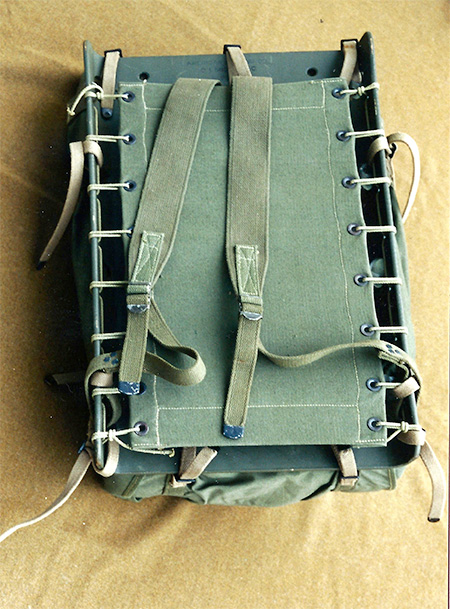
Illustration of Packwood, Plywood, QMC Stock No. 74-P-27-20. This is the second type replacing the Packwood, QMC Stock No. 74-P-25, aka the “Yukon” Packboard. (canvas and wooden carrying frame for transporting loads by manpower).
The Canvas Medical Pack was designed to be attached to the early “Yukon” (Packboard QMC Stock No. 74-P-25) and later Plywood Packboard (Packboard QMC Stock No. 74-P-27-20, MD Item No. 9778700) for easy and individual transportation. When used with the Plywood Packboard, no attachments could be used (Attachment, Packboard, Plywood, Cargo, Stock No. 74-A-33-25). The Packboard carrying frame allowed for a better distribution of a heavy load which could then be carried with relative ease.
As far as the authors are aware five (5) different Medical Packs were introduced in 1944. They included:
- Pack No. 1, Unit Medical Equipment, MD Item No. 9794100
- Pack No. 2, Unit Medical Equipment, MD Item No. 9794200
- Pack No. 3, Unit Medical Equipment, MD Item No. 9794400
- Pack No. 4, Unit Medical Equipment, MD Item No. 9794600
- Pack No. 5, Unit Medical Equipment, MD Item No. 9794800
Container, Aerial Delivery, Type A-4:
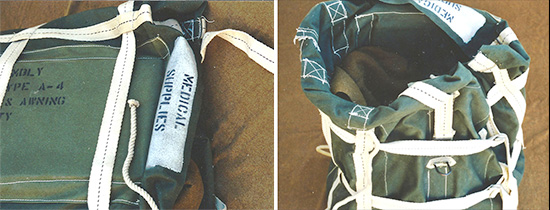
Left: Illustration of Container, Aerial Delivery, Type A-4, please note the special indication “Medical Supplies”.
Right: Illustration of the same Container. It is interesting to note that this item had the word “Caution” stenciled on the Container’s edges (not visible on the photograph).
Because of the limited amount of equipment and supplies that can accompany Air Landing troops, provision for early and continuous replenishments of ammunition, food, water, medical, and other essentials had to be arranged by the TF commanders. Especially Airborne Forces frequently required special equipment or additional numbers of standard items, such as communications equipments, weapons, ammunition and demolition equipment, rations, and medical supplies. Owing to the lack of transportation for hauling supplies, consideration had to be given to dropping “emergency” supplies by parachutes. Moreover, because of the difficulties of evacuation, medical supplies had to be ample, hence the provision for resupply by air – in bundles or in containers.
There were three (3) “general” types of delivery units, classified according to loads carried, and generally consisting of 3 main parts: the Container or Harness, the Canopy, and the Pack Assembly. . The “unit type” was designed to carry squad or unit loads of arms and general equipment. The “general types” were designed to carry food, water, medical supplies, certain types of ammunition, and other miscellaneous equipment or supplies. The “special type” were those designed to carry one particular piece of equipment or supply, such as boxed ammo, handcarts, motorbikes, or crates containing pigeons.
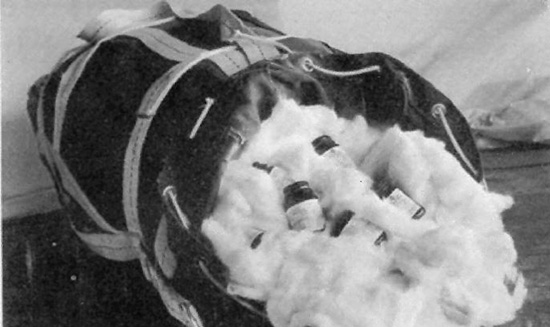
Illustration of Container, Aerial Delivery, Type A-4, filled with small medical items wrapped in cotton for enhanced protection.
The item described in this short article is of the “General Type”, A-4. This Aerial Delivery unit consisted of a box-type container, a 24-foot circular cotton canopy, and a conventional “pull off” pack assembly. The main piece of equipment is a rectangular bag of olive drab duck, 30” x 24” x 12”, reinforced on the bottom by plywood, and on top by a metal frame which includes rings for suspension on aircraft bomb racks. It contains a suitable suspension harness of webbing. Inside the bag may be placed 2 cardboard or light wooden boxes, each 12 x 12 x 30 inches. However, if necessary, supplies could be packed in the container without the use of boxes. Loads for the type A-4 Delivery Containers were limited to 200 pounds, including the weight of the container. Any sharp edges or protruding surfaces were to be avoided and brittle or breakable items had to be protected by padding.
It was eventually recommended to use the type A-4 container chiefly when there was need for heavy padding to protect fragile equipment or supplies, such as radio equipment and medical supplies.

Illustration of the various Colored Canopies used during Operation “Varsity” 24 – 28 March 1945. Color codes varied according to the nature of supplies dropped, and could be adapted for future operations.
A scheme of distinctive markings was designed to enable personnel to determine quickly the contents of the different loads and their destinations. The most satisfactory method was the use of colored canopies and, by prearrangement, have each color indicate the nature of the load (the parachute color codes used in WWII were GREEN – BLUE – RED – YELLOW – and NATURAL (white). Also large numbers or letters, in different colors, either stenciled or sewed on to the canopies were used. For deception, it was recommended to vary the types of loads dropped with various colors, and to keep the information restricted to a particular organization.
Utah Beach Medical Bag:

Front and rear views of the special Bag issued to members of the 4th Infantry Division Medical Detachments on D-Day. Note the large adjusting straps running along the Bag, and the integrated Suspender-style shoulder straps.
A close study of photographs taken on Utah Beach of 4th Infantry Division medical personnel reveals that the unit was issued with a specially designed bag to hold medical supplies. The Bag was heavily based upon the Navy Shore Bag which was a standard piece of US Navy Medical Department equipment during WW2. Indeed, photographs taken during training exercises in England in the run-up to the invasion of Normandy show these latter Bags in use by 4th Infantry Division Medical Detachment personnel, and it is likely that these were obtained from the Navy Beach Battalions also training with the units.
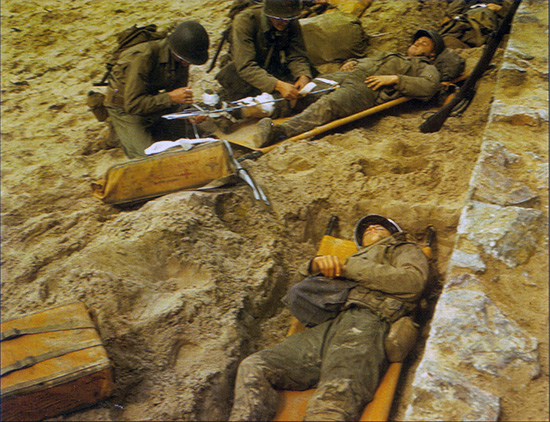
This rare color photograph taken during Exercise Tiger (invasion training on the west coast of England), clearly shows the Navy Shore Bags being used to carry medical supplies. Note that these Bags can be identified as Navy models by the markings applied to the side of each unit.
Unfortunately, since these items are such a specialized piece of equipment, and due to the fact that they were not widely issued outside of the 4th Infantry Division, little is known about their contents. The Bag itself is of an extensible design allowing its interior capacity to be altered depending upon the situation. Two straps are secured around the length of the Bag, and are closed by standard buckles. These straps can be adjusted allowing the top of the Bag to be rolled down as required.
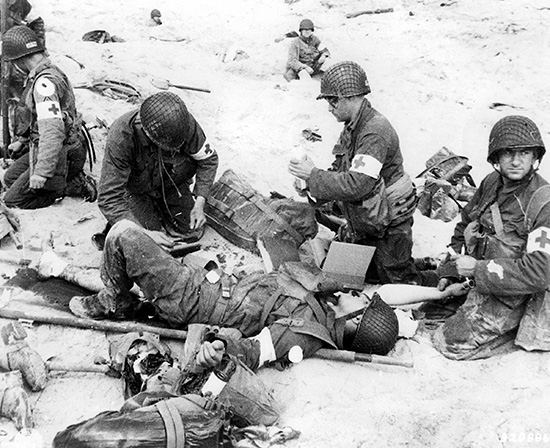
Medical personnel of the 4th Infantry Division treat a wounded fellow medic on Utah Beach. This photograph, taken on 6 June 1944, clearly shows this idiosyncratic Bag.
This item also features an integrated carrying mechanism, which is heavily designed around the Medical Suspender. Two wide shoulder straps are provided for comfort, and are also attached to a strap and buckle, allowing them to be fully adjusted to suit any condition. The Bag is reinforced on each seam, but unlike its Navy-issue counterpart, this specially made Bag for the 4th Infantry Division does not feature a fiberboard reinforcing plate at the bottom.
Original bags are devoid of any markings and can be found of both khaki (OD #3) and green (OD #7) construction.
Kit, Mortar Shell Case:
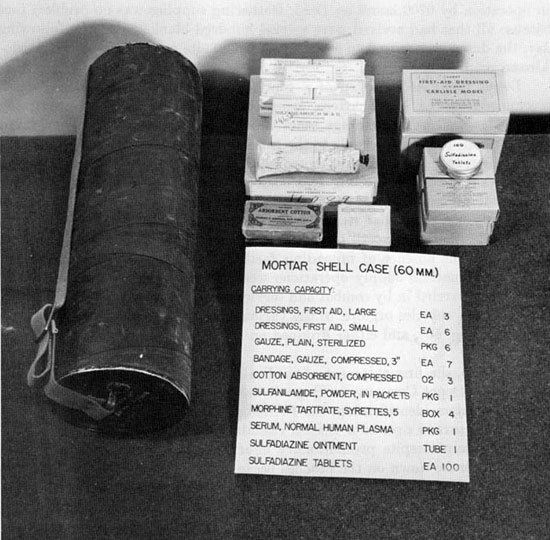
Photograph showing the improvised container made from a 60mm Mortar Shell Case. Notice the modified EM Trouser Belt used as a carrying handle.
During the first few days of Operation Neptune, the unloading of medical equipment and supplies was irregular, delayed and confused. One of the biggest problems which was faced by the medical teams on the beachheads was locating and gathering the numerous medical supply boxes, which were largely interspersed with the huge amounts of other supplies among the area. As a result, aid men and medical teams began to use supplemental methods of resupply, such as mortar shell cases, Assault Vests, and two-man carry maintenance units.
Discarded waterproof fiber shell cases were found very convenient and practical to protect medical supplies during the initial landings in an amphibious operation. Small holes were punched in the metal covers at the top and bottom of the container so that the hooks of any medical strap could be placed in these, allowing the fiber container to be carried over the shoulder. The material was waterproof, comfortable to carry, would float, and could be obtained in various sizes.
Close scrutiny of contemporary photographs show that the most common variant of mortar shell case used during the D-Day Operation was that of the 60mm Mortar. The cases were modified by adding a small loop to the end caps, and then attaching an Enlisted Men’s Trouser Belt (open face) which acted as a carrying handle or strap for slinging the container over the shoulder. Since the cases were constructed from waxed cardboard, the contents would be thus protected from the water during wading ashore, and also against the damp elements typically found on the beachhead. Some sources indicate that the use of empty shell cases to protect medical supplies also took place during the Anzio landings.
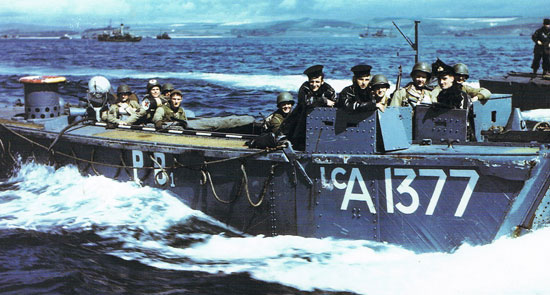
Color photograph showing US Army Rangers preparing for the Invasion of Normandy in Weymouth, England. Notice the Medic in the rear of the British LCA carries
a modified Mortar Shell Case marked with a Geneva Convention symbol on the metal end cap. Also of interest is the fact that the Medic has applied Geneva
Convention markings to his M1 Helmet, which was uncommon for the initial invasion of Normandy.
The recommended contents for the kit were as follows:
| Mortar Shell Case (60mm): | ||
| Large Carlisle Dressing | 3 | |
| 2030000 | Packet, First-Aid, Carlisle Model | 6 |
| 2021000 | Gauze, Plain, 36-Inch, 5-Yard Roll | 6 |
| 2003185 | Bandage, Gauze, Compressed, 3 In. x 4 Yds. | 7 |
| 2014000 | Cotton, Absorbent, Compressed, 1 oz | 3 (ounces) |
| 9121100 | Sulfanilamide, Crystalline, 5, 5-Gm Envelopes | 1 (box) |
| 9115500 | Morphine Tartrate, 5 Tubes | 4 (boxes) |
| 1608900 | Plasma, Normal Human, Dried, 250 cc | 1 (box) |
| 9104000 | Tannic Acid Sulfadiazine Ointment | 1 (tube) |
| 1462200 | Sulfadiazine TabletsSulfadiazine, 1,000 Tablets | 100 |
Although very little official documentation exists regarding this item, ETO General Board Report 093 discusses the use of the 60mm Mortar Shell Case as a means of carrying medical equipment. Although the report indicates that the data was taken from the 4th Infantry Division, it can be assumed that the following information is valid for other units that used the Mortar Shell Case:
All Medical Enlisted Men carried a 60mm Mortar Shell outer container, M51A1, packed with 12 ½ lbs of surgical dressings, drugs and blood plasma. To permit carrying in the manner of a golf-bag over one shoulder a ring of light wire was soldered on each metal end of the container and a 32-inch canvas strap with buckle (EM Trouser Belt -ed) was attached. A 6-inch white circle, housing a Geneva Red Cross, was painted on each end of the container.
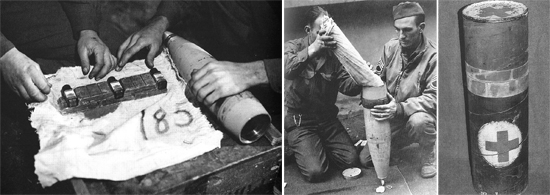
More illustrations exist showing the use of empty shells, containers, and canisters being used to be fired or dropped to isolated or surrounded American troops in order to provide them with badly-needed medical supplies.
In addition to the information provided above, the MRC staff were recently made aware of the following texts, which appeared in the Bulletin of the US Army Medical Department #89 (dated June 1945), which discusses the use of specially-treated Mortar Shell Cases, specifically by the First United States Army during Operation “Neptune”. The following excerpt was kindly provided by sgtpeter:
Medical Supply Officers of the First United States Army, while planning the amphibious assault on Normandy, were troubled by the small space allocated to medical supplies and equipment.
For the assault troops, moreover, there was designed a special waterproof unit of supply, which was carried ashore by the aid men and which served as additional life preservers. This unit consisted of seven specially treated mortar shell cases, and contained a total of 100 first-aid dressings, 50 packages of sterilized gauze, 50 three-inch bandages, 10 packages of sulfanilamide, 25 boxes of morphine syrettes, 7 packages of normal human plasma, 1000 sulfadiazine tablets, 100 halazone tablets and 1 sterile gauze packet impregnated with boric acid or petrolatum. The foregoing supplies were issued to troop units scheduled to arrive on the far shore during the first four days on the following basis: one unit of supply per Infantry, Artillery, Chemical, Engineer, and Ranger Battalions; two units per Collecting Company, divisional; four units per Clearing Company, divisional; and six units per Medical Battalion (Engineer Special Brigades). These units proved to be extremely valuable in the early hours of the assault, when the unloading of scheduled medical supplies was delayed.
The authors would like to extend their sincerest thanks to the Carentan Historical Center for kindly allowing use of some of the illustrations which appear in this Article. In addition, we are continually looking for additional data and information relating to any extraordinary medical packs and bags. If any readers are able to provide additional data about unit-specific items or packs, please contact the WW2 US MRC.
